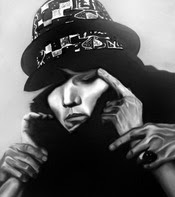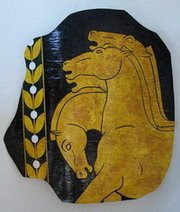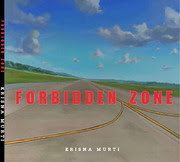 Photography: Goenadi Haryanto
Photography: Goenadi HaryantoThough no crowd – it means: less audiences – but the opening night (Friday, December 7th, 2007) was great. I talked about “Blank Spot” photo exhibition. Some hearted art-lovers, RSY’s friends, and students enjoyed the photos. And some of them stayed patiently until the artist talk session finished.
Mr Tjahjono Rahardjo, lecturer of Urban and Environment, Post-Graduate Programme, Soegijapranata Chatolic University, gave his notes on the Semarang Old Town. It was a Dutch colonial living area but now many all of its buildings were emptied and have no significant functions.
 “By exploring this area, just on foot, we can learn different architectural styles,” said Mr Rahardjo. The area was built during 1880 to 1930’s. He also described the political lives related to this area during the Soekarno’s reign, Soeharto’s dictatorship, and now in the Reformasi Era.
“By exploring this area, just on foot, we can learn different architectural styles,” said Mr Rahardjo. The area was built during 1880 to 1930’s. He also described the political lives related to this area during the Soekarno’s reign, Soeharto’s dictatorship, and now in the Reformasi Era.
It seems that there are no enough attentions how to handle this wonderful area where many old buildings still existed. In fact, only little are used and cared properly.
But in other part of his speech, Mr Rahardjo did not agree to the term ‘blank spot’ used as the title of the exhibition. According to him, this area still existed and attracted so much attentions from Government, in short: abundant of money were poured down. But nothing developed well, I claim.
The ‘blank spot’ curatorial framework based on thoughts: the area is between existed nor in-existed for the reasons no significant development implemented there.
 Five photographers who are taking part to this exhibition show their multifaceted pictures. Agus Leonardus, famous photographer and a lecturer worked at Yogyakarta, makes interesting metaphor to this Old Town. He only show single picture: there are dozens people – actually the same person – are sleeping on the road in front of Gereja Blenduk (simply as Round Church) which is a landmark of the cityscape. He critizises the local government included citizens which are not awaken.
Five photographers who are taking part to this exhibition show their multifaceted pictures. Agus Leonardus, famous photographer and a lecturer worked at Yogyakarta, makes interesting metaphor to this Old Town. He only show single picture: there are dozens people – actually the same person – are sleeping on the road in front of Gereja Blenduk (simply as Round Church) which is a landmark of the cityscape. He critizises the local government included citizens which are not awaken.
Goenadi Haryanto, Hendro Wasito, and William Wong pick up the reality they found in the area. The senior photographer Goenadi Haryanto, known as a leading one in Indonesian photo salon community, visualized his observation on the street lamp related to and important for the safety reasons. This Jakarta based photographer thinks as if the area were unsafe.
 The night scene really underlines the term ‘blank spot’ and Hendro Wasito, an amateur photographer but a leading Semarang art collector, tells us how tranquil the area is. Almost none activities found in the night and in some terraces of old buildings there are many homeless laying down embracing their dreams. Wasito clearly shows his position to people who are oppressed and do not get enough care from others.
The night scene really underlines the term ‘blank spot’ and Hendro Wasito, an amateur photographer but a leading Semarang art collector, tells us how tranquil the area is. Almost none activities found in the night and in some terraces of old buildings there are many homeless laying down embracing their dreams. Wasito clearly shows his position to people who are oppressed and do not get enough care from others.
William Wong’s dozens photos of doors and windows are definitely signs of destruction. Those are left alone and imply both government and citizens never care of them. Indeed, some are extremely good looking.
Wearing traditional Javanese costume Ferintus Karbon walked alone in the area and thought he was a lost tourist. Not only as a humble tourist but he also underlines being a Javanese in the Dutch colonial area. Moreover he seems criticize the government programme, that is Semarang Pesona Asia. This programme was politically arranged by the Mayor to attract foreign tourists coming to Semarang. Frankly speaking this programme was not as successful as it is claimed by the government.
In short, this photo exhibition brings a different point of view on the Old Town. And it shows that photography is not only means of recording but also as a media expressing ideas.***
Mr Tjahjono Rahardjo, lecturer of Urban and Environment, Post-Graduate Programme, Soegijapranata Chatolic University, gave his notes on the Semarang Old Town. It was a Dutch colonial living area but now many all of its buildings were emptied and have no significant functions.
 “By exploring this area, just on foot, we can learn different architectural styles,” said Mr Rahardjo. The area was built during 1880 to 1930’s. He also described the political lives related to this area during the Soekarno’s reign, Soeharto’s dictatorship, and now in the Reformasi Era.
“By exploring this area, just on foot, we can learn different architectural styles,” said Mr Rahardjo. The area was built during 1880 to 1930’s. He also described the political lives related to this area during the Soekarno’s reign, Soeharto’s dictatorship, and now in the Reformasi Era.It seems that there are no enough attentions how to handle this wonderful area where many old buildings still existed. In fact, only little are used and cared properly.
But in other part of his speech, Mr Rahardjo did not agree to the term ‘blank spot’ used as the title of the exhibition. According to him, this area still existed and attracted so much attentions from Government, in short: abundant of money were poured down. But nothing developed well, I claim.
The ‘blank spot’ curatorial framework based on thoughts: the area is between existed nor in-existed for the reasons no significant development implemented there.
 Five photographers who are taking part to this exhibition show their multifaceted pictures. Agus Leonardus, famous photographer and a lecturer worked at Yogyakarta, makes interesting metaphor to this Old Town. He only show single picture: there are dozens people – actually the same person – are sleeping on the road in front of Gereja Blenduk (simply as Round Church) which is a landmark of the cityscape. He critizises the local government included citizens which are not awaken.
Five photographers who are taking part to this exhibition show their multifaceted pictures. Agus Leonardus, famous photographer and a lecturer worked at Yogyakarta, makes interesting metaphor to this Old Town. He only show single picture: there are dozens people – actually the same person – are sleeping on the road in front of Gereja Blenduk (simply as Round Church) which is a landmark of the cityscape. He critizises the local government included citizens which are not awaken.Goenadi Haryanto, Hendro Wasito, and William Wong pick up the reality they found in the area. The senior photographer Goenadi Haryanto, known as a leading one in Indonesian photo salon community, visualized his observation on the street lamp related to and important for the safety reasons. This Jakarta based photographer thinks as if the area were unsafe.
 The night scene really underlines the term ‘blank spot’ and Hendro Wasito, an amateur photographer but a leading Semarang art collector, tells us how tranquil the area is. Almost none activities found in the night and in some terraces of old buildings there are many homeless laying down embracing their dreams. Wasito clearly shows his position to people who are oppressed and do not get enough care from others.
The night scene really underlines the term ‘blank spot’ and Hendro Wasito, an amateur photographer but a leading Semarang art collector, tells us how tranquil the area is. Almost none activities found in the night and in some terraces of old buildings there are many homeless laying down embracing their dreams. Wasito clearly shows his position to people who are oppressed and do not get enough care from others.William Wong’s dozens photos of doors and windows are definitely signs of destruction. Those are left alone and imply both government and citizens never care of them. Indeed, some are extremely good looking.
Wearing traditional Javanese costume Ferintus Karbon walked alone in the area and thought he was a lost tourist. Not only as a humble tourist but he also underlines being a Javanese in the Dutch colonial area. Moreover he seems criticize the government programme, that is Semarang Pesona Asia. This programme was politically arranged by the Mayor to attract foreign tourists coming to Semarang. Frankly speaking this programme was not as successful as it is claimed by the government.
In short, this photo exhibition brings a different point of view on the Old Town. And it shows that photography is not only means of recording but also as a media expressing ideas.***







+of+DSC05301.jpg)





No comments:
Post a Comment